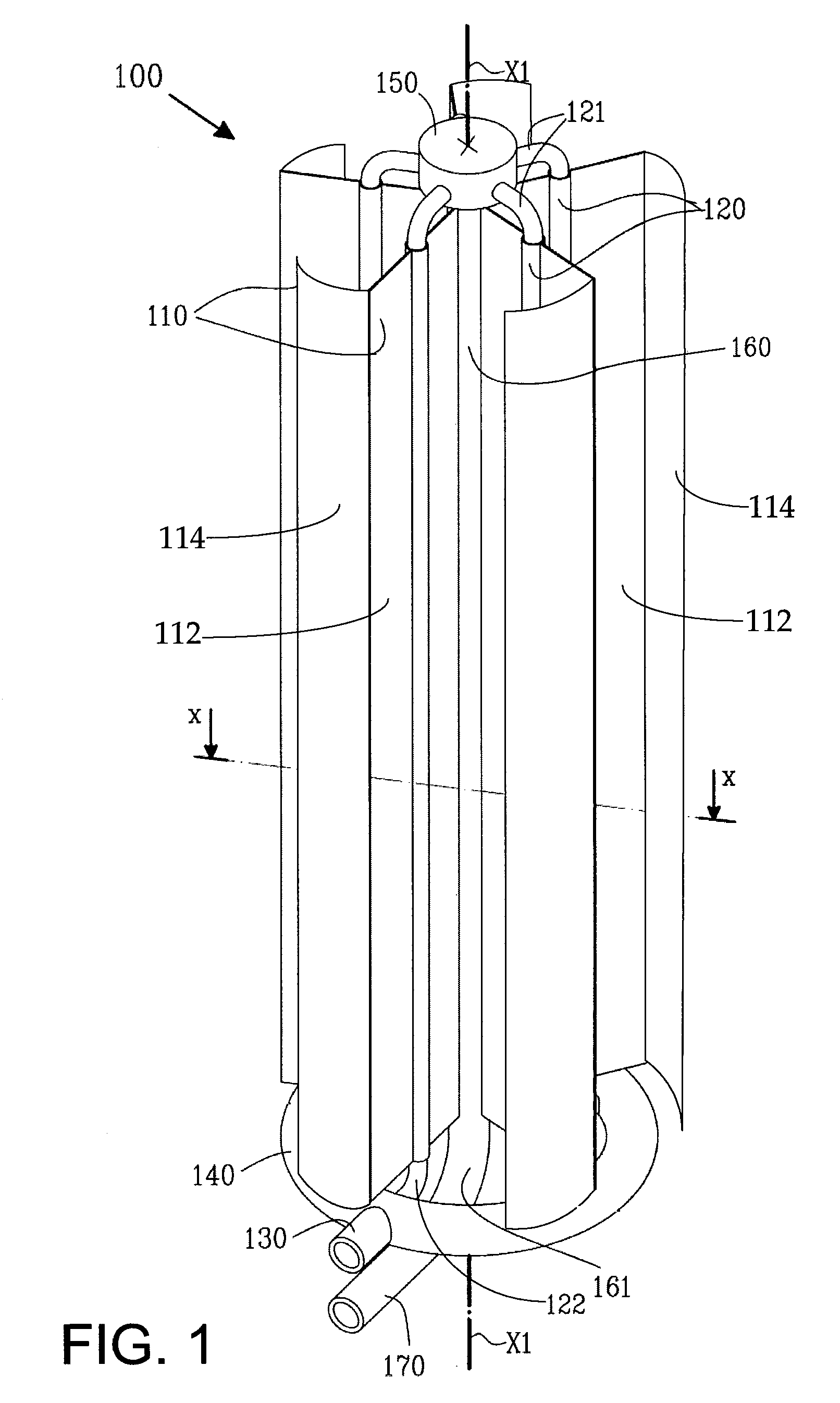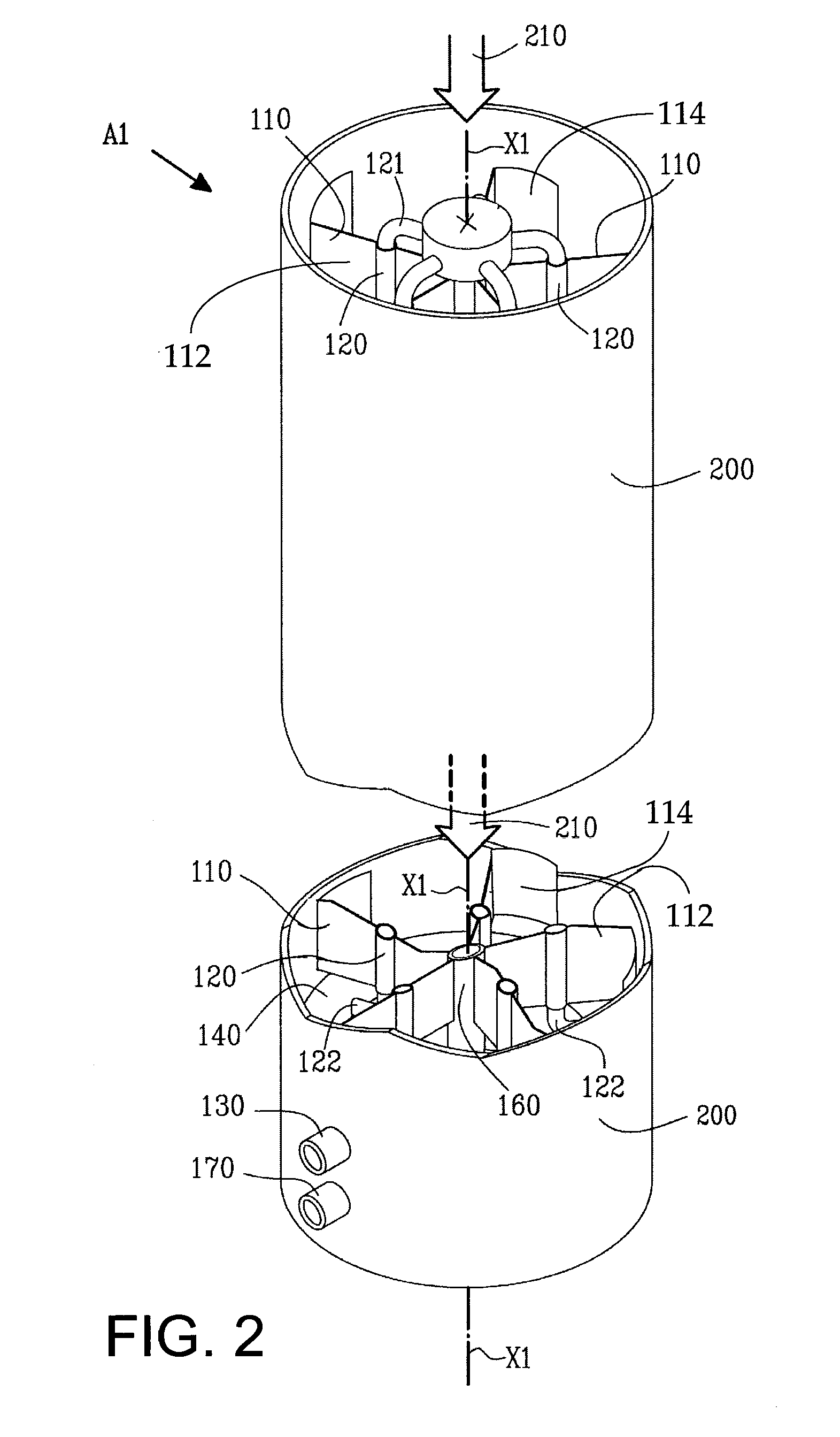Axial Heat Exchanger for Regulating the Temperature and Air Comfort in an Indoor Space
a heat exchanger and indoor space technology, applied in the direction of lighting and heating apparatus, tubular elements, stationary conduit assemblies, etc., can solve the problems of particularly unsuitable heat exchangers for regulating temperature, and achieve the effect of increasing the heat exchanging surface and the amount of dead spa
- Summary
- Abstract
- Description
- Claims
- Application Information
AI Technical Summary
Benefits of technology
Problems solved by technology
Method used
Image
Examples
second embodiment
[0027]The sheets or fins 100 have first component 112 and a second component 114. The first component 112 of the sheets or fins 110 in FIGS. 1 and 2 extends in a radial direction, in addition to extending in an axial direction as previously explained. The radial direction extends substantially outwards from the centre or centre axis of the heat exchanging structure 100 towards the outer channel structure 200. This extends ends at a distance from the outer channel wall. The second component 114 of the sheets or fins 110 extends along the wall of the outer channel 200, i.e. substantially tangentially from the end of the first component 112 near the outer channel structure. The second component is in the shown embodiment curved, with a curvature identical or similar to the curvature of the outer channel. However, the second component could also be a not curved panel, as disclosed with the second embodiment below, or could be formed by two or more panels that are connected to one anothe...
third embodiment
[0040]FIG. 6 shows a schematic cross-section of another possible pattern for arranging the fins or sheets within an outer channel of an axial heat exchanger according to an embodiment of the present invention. This third embodiment has no central inner channel 60.
[0041]FIG. 7 shows a schematic cross-section of an axial heat exchanger according to fourth that is essentially the same as the previously discussed axial heat exchanger A1 shown in FIGS. 1-2. However, the outer channel 200 of the heat exchanger A1 with a circular cross section has been replaced in FIG. 6d by an outer channel structure 600 with a hexagonal cross section. The shape of the second components of the sheets 110 has been adapted correspondingly.
[0042]FIG. 8 shows the same axial heat exchanger as the one shown in FIG. 7, with the exception that the axial heat exchanger in FIG. 8 has four fins 110 instead of six fins 110 as in the heat exchanger shown in FIG. 7. It is especially advantageous to provide the rectangu...
first embodiment
[0047]FIG. 4 shows a plurality of axial heat exchangers A1 according to the invention as discussed above in connection with FIGS. 1-2. The heat exchangers A1 have been arranged in parallel to enable a substantially simultaneous flow of a first medium (preferably air) through each the heat exchanger A1 along the medium channel or channels 210 as discussed above in connection with FIG. 2. The heat exchangers A1 must not be arranged side by side along a straight line as in FIG. 5b. On the contrary, the heat exchangers A1 may be arranged side by side in a circle or in a semi-circle, or in a square or according to some other polygonal pattern.
[0048]Each parallel heat exchanger A1 in FIG. 5b have been coupled to a supply channel arrangement extending along the parallel heat exchangers A1 for providing each exchanger with a second medium (preferably water). Accordingly, the lower distribution manifold 130 of each heat exchanger A1 has been coupled to a first supply channel 710, whereas the...
PUM
 Login to View More
Login to View More Abstract
Description
Claims
Application Information
 Login to View More
Login to View More - R&D
- Intellectual Property
- Life Sciences
- Materials
- Tech Scout
- Unparalleled Data Quality
- Higher Quality Content
- 60% Fewer Hallucinations
Browse by: Latest US Patents, China's latest patents, Technical Efficacy Thesaurus, Application Domain, Technology Topic, Popular Technical Reports.
© 2025 PatSnap. All rights reserved.Legal|Privacy policy|Modern Slavery Act Transparency Statement|Sitemap|About US| Contact US: help@patsnap.com



